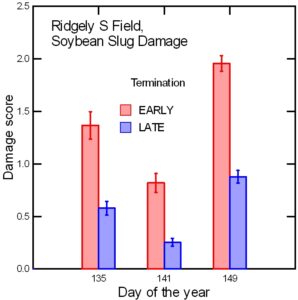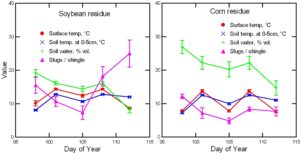Progress report for LNE23-481R
Project Information
Cover cropping is a soil health best management practice, but <10% of US farms and <15% of Northeast farms regularly use cover crops (CCs) and fewer manage CCs to maximize benefits for farmers and society. A key question is when to terminate CCs in spring, either mechanically or with herbicides. Farmers typically terminate CCs when small and “easy to deal with.” Delayed termination allows CCs to grow longer and may triple biomass produced, therefore greatly increasing such benefits as erosion control, weed suppression, nutrient cycling, nitrogen fixation, compaction alleviation, and summer water conservation. Farmers who use CCs are increasingly interested in facilitating late CC termination by “planting green” (PG), a practice whereby a cash crop is no-till planted into a living green CC with termination performed either simultaneously or a few days to weeks later.
Increasing climate change concerns have stimulated emerging markets that pay farmers to sequester carbon in soils. Current models have little-to-no basis for estimating carbon in CC roots. Data are therefore urgently needed on how CC termination timing affects root carbon contributions, which are more important than shoot contributions for carbon sequestration. Another issue lacking data and of concern to farmers is that CCs may increase slug problems. Finally, farmers need data on how termination timing affects weeds and soil moisture. We hypothesize that 1) shoot/root ratios are not constant over time and PG may optimize both root and shoot carbon sequestration; 2) green CCs coexisting with cash crop seedlings may distract slugs and reduce cash crop damage; 3) planting green may optimize weed suppression and summer water conservation.
We will conduct experiments on-station research with coarse and fine textured soils, and on-farm research at four to six collaborating farms. The on-station experiments will test three termination timings relative to cash crop planting (three-four weeks prior; simultaneously with; one-two weeks after) and three CC types (no-cover control; grass-legume or grass-brassica-legume mixture; and pure winter cereal) in a no-till corn-soybean production system. Collaborating farms will use 2-4 treatments (farmer’s choice) per farm. Farmers will conduct all operations and measure yields while researchers will collect data on shoot/root biomass, slug damage, crop stands, seed placement, datalogger-sensed soil moisture and temperature, weed biomass and residue cover at canopy closure, and shoot nutrient content, as appropriate.
Researchers and farmers will keep detailed notes on planter settings, and operational issues such as CC wrapping, seed placement, slot closing, and machine wear. Lessons learned will be promulgated through extension efforts to reduce risk barriers for farmers wanting to grow more effective CCs that are more beneficial for their farm and ecosystem services. Farmers help design the research and those with PG experience will mentor other farmers wanting to try PG. An advisory board will guide the direction of the project, which will strive to include a range of farm types and sizes.
During the first six months of the project, we have recruited and onboarded a graduate student who will conduct much of the day-to-day research operations. Three farmers have planted cover crops and designed on-farm trials to answer questions they have about termination methods and timing. Several additional farmers have indicated an interest in establishing spring on-farm trials using cover crops they already have growing in their fields. The cover crop treatments for the on-station experiments were successfully established by overseeding into standing soybean and corn canopies in September 2023. Dataloggers are presently sensing and recording soil moisture and temperature at two depths on an hourly basis on these experimental fields.
Research to optimize spring cover crop management with a focus on comparing termination methods and termination timing (from several weeks before to several weeks after cash crop planting). We will learn how these practices affect root and shoot carbon contributions, soil moisture use and conservation, weed and slug pressure, soil health functions, farmer costs and crop yields. Our results will reach 100s of farmers who are on-the-fence about cover crops or use them in ways that provide little benefit, and provide the confidence and information they need to adopt cover cropping with late termination practices that maximize cover crop benefits.
Cover cropping is a widely-recommended soil health best management practice. As a result of attention in the farm press, examples set by respected farmers, and financial incentives provided by various agencies, farmer interest in trying cover crops (CC) and their adoption of CCs increased substantially between 2012 and 2017 Ag census, but is still, <15% in most NE States and <10% in most states nationally. Cover crops are now used on all types of farms, from large-scale grain to small vegetable operations, and even in hoophouses.
Adoption of CCing is only a first step. Like cash crops, CCs require thoughtful systems management to maximize benefits. One issue limiting CC effectiveness is that most farmers terminate CCs relatively early, which inhibits CC benefits. As a result, most farmers experience little or no increase in crop yields or observable increase in soil organic matter from CCs. They are therefore not motivated to continue using CCs or invest in their management. Typically, farmers terminate their CCs about a month ahead of cash crop planting when CCs are small because “covers are easier to kill when small”, “the residues need a few weeks to dry down and become easy plant through”, “they want to get that job out of the way”, to avoid CCs “getting away from” them, to avoid residue “winding around planter closing wheels”, to avoid possible competition with crops for stored soil moisture, or to reduce anticipated slug damage to emerging cash crops.
A key research question is when to terminate CCs, either mechanically or with herbicides. Delaying termination as late as possible in spring allows CCs to grow longer and may triple biomass produced, therefore greatly increasing such benefits as carbon sequestration, erosion control, weed suppression, nutrient cycling, nitrogen fixation, compaction alleviation, and summer water conservation. Farmers who use CCs are increasingly interested in facilitating late CC termination and greater CC benefits by “planting green” (PG), a practice where a cash crop is no-till planted into a living green CC with termination performed either simultaneously or a week or two later. This relatively new and still rarely used practice could greatly improve CC benefits on thousands to even millions of annual cropland acres on Northeast farms of all sizes.
To be willing to try PG practice farmers need information on planting techniques and equipment settings and how to reap increased benefits while avoiding pitfalls. One issue is the lack of data addressing farmer concerns that CCs may increase slug problems if not terminated early. Farmers also need better data on how termination timing affects weeds and soil moisture.
Increasing climate change concerns have stimulated emerging markets that pay farmers to sequester carbon in soils. Current carbon sequestration models such as COMET-Farm (USDA/NRCS, 2022) have little-to-no basis for estimating carbon in CC roots. Data are urgently needed on how CC termination timing and PG affect carbon contributions and soil organic matter, especially belowground, as root contributions are nearly twice as effective as shoot contributions for carbon sequestration.
Cooperators
- (Educator and Researcher)
- (Educator)
Research
Compared to early termination and planting into dead CC residues, planting green with properly adjusted equipment will:
- Achieve equally good seed placement, furrow closure and stand uniformity;
- Conserve summer soil moisture and reduce crop water stress;
- Reduce weed biomass before canopy close;
- Not affect slug numbers but decrease slug damage to cash crops;
- Increase above- and below-ground plant carbon inputs, increase stabilized soil carbon and Active Carbon in 0-30 cm soil by third year;
- Reduce time and herbicide used for CC management.
- Increase yields in site-years with wet spring and dry summer.
- Treatments: Proposed treatments with rationale for selection.
Replicated experiments use one cash crop (e.g. soybean, dry beans, sweetcorn, dent corn, industrial hemp) or rotations of cash crops according to farmer preferences. On-station trials use a soybean-corn rotation with each cash crop represented in each year.
For on-station trials, treatments comprise factorial combinations of CC termination times and CC species (including no CC) as listed below. Nine factorial combinations (marked by * below) are used (3 termination times x 3 CC species = 9 treatments). For on-farm trials, farmers choose at least two termination times or methods and 1-2 cover crops or cash crops to give 2 to 4 treatment combinations. On most farms these treatment are replicated 3 to 4 times and represented in strip plots large enough to manage with normal farm machinery.
Early, Mid and Late termination dates (in relation to optimal cash crop planting date for the site):
- *Early: 2-4 weeks prior to cash crop planting (08-12 April in Maryland). Chosen to represent the current standard practice of killing CCs while small and “planting brown”.
- *Mid: simultaneous with cash crop planting (planting green, 1-5 May in Maryland). Chosen to represent the most common, least complex PG.
- *Late: 1-2 weeks after cash crop planting. In Maryland, planting green in early May but waiting until mid-May to terminate, allows CCs to theoretically maximize aboveground biomass and reach the reproductive stage necessary for roller-crimping.
CCs species used (including a no-cover crop winter -weeds only control):
- *No CC (winter weeds only). A no-cover control included as the standard practice for many farmers who are still on the fence about using cover crops.
- *Winter cereal (Cereal rye or other winter cereal chosen by farmer). Most common standard cover crop. In Maryland winter wheat is the most popular, while cereal rye is second most popular and the most often recommended for its winter hardiness and effectiveness nitrogen capture.
- *Grass-brassica-legume mixture (farmer choice from each group plus others, if desired). This 3-species CC works well in the mid-Atlantic, with rye, radish, and crimson clover being most popular species. This CC provides aggressive fall growth and nutrient cycling by brassica, and long-lasting mulch from cereal, but without the nitrogen immobilization and yield drag single-species cereal CCs often entail.
- Grass-legume mixture (farmer choice of species). Similar to #3 above, but no brassica for farmers with brassica crops in rotation or desire to limit CC seed costs.
- Methods: Experimental design, experimental unit size, and treatment application.
On-station experiments. Randomized complete block design with split-split-plot arrangement of treatments within blocks. Experiment will be repeated on two sites representing range of Mid-Atlantic soils, one excessively well-drained sandy soil and the other moderately well-drained clayey soil. Main plots have either corn or soybean cash crop. Subplots are three CC species treatments: no cover, 3-species mix, and cereal rye. Subsubplots are termination dates: early, mid, and late. Experimental unit is the subsubplot which will measure 30 ft x 60 ft to accommodate farm-scale equipment. The experiments have four replications at each site and conducted for 3 years using same treatments on each experimental unit, giving 6 site-years of data.
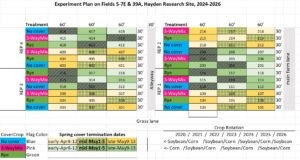
On-farm trials research goals. Four to eight on-farm trials will be established, with the expectation that three to six will result in usable data. If possible, each will use a randomized complete block design with three replicate blocks. If possible, the same plots will host a given treatment for two to three consecutive years on a given farm. Two to six treatments (farmer's choice of 2 termination times x 1-3 CC/crop species) will be applied in simple strip plots with a total of 6 to 18 plots (experimental units) per farm. On-farm plots sized to accommodate farmer's land and equipment. Each trial will feature one cash crop (farmer’s choice) in a given year. For combine-harvested cash crops, plots will be long enough (>150ft) to obtain reliable data from calibrated yield monitors. Smaller plots may be used for crops requiring smaller equipment or hand-harvesting. Treatments are randomly assigned to plots within each block. Blocks are laid out to maximize uniformity within the block. Replicate blocks on a farm not necessarily in one field. Cover crop establishment and termination and cash crop planting and harvesting are accomplished by the farmer using their normal equipment.
For both on-station and on-farm trials cash crop planter adjustments will be optimized for plant and soil conditions, meaning adjustments may be made between plots with different treatments.
On-Farm Trials Conducted in 2024
In spring 2024, on-farm cover crop management trials were established on four commercial farms, as described below.
Steve Groff’s Cedar Meadow Farms is located in Lancaster County, PA. Steve is interested in trying a multispecies cover crop as a spring-planted companion crop to aid in the establishment of industrial hemp. Adjacent plots of industrial hemp with and without companion cover crops were planted in spring 2024 in a field located at 39°52.3783'N 76°16.9226'W. Hemp was seeded in 6 inch rows at ~405,000 seeds per hectare, across approximately 10 hectares. Companion cover crop seed was mixed with the industrial hemp seed. The idea was to have the cover crop species growing at the same time as the slow-starting hemp seedlings to offer protection from weather and slugs, then have the accelerating growth of the hemp eventually swamp the cover crop species, leaving them to die and mulch under the dense tall hemp stand. The following companion cover crops and respective seeding rates were use: 1.12 kg/ha of ‘radish’, 0.112 kg/ha of ‘oilseed rape’, 2.24 kg/ha of ‘meadowfoam’, 3.36 kg/ha of ‘annual ryegrass’, 11.12 kg/ha of ‘black oats’, 2.24 kg/ha of ‘dwarf white blossom clover’, 1.12 kg/ha of ‘phacelia’, 2.24 kg/ha of ‘red clover’, 0.112 kg/ha of ‘mustard’, 5.60 kg/ha of ‘barley’, 11.12 kg/ha of ‘cereal rye’, 11.12 kg/ha of ‘soybeans’, and 11.12 kg/ha of ‘wheat’.
Jim Lewis’ farm is located at 38°58.1303'N 75°50.7748'W in Ridgely, MD. Dominant soil series present according to USDA WSS are “Hambrook loam, 0 to 2 percent slopes”, “Ingleside sandy loam, 2 to 5 percent slopes”, and “Hambrook sandy loam, 0 to 2 percent slopes.” The Lewis farm grows primarily a soybean/corn rotation under no-till management and has used cover crop for more than 20 years. Two treatments of cover crop termination timings were established following harvest of soybean and corn in fall 2023. Different cover crop species were used depending on the preceding cash crop. Following soybean and preceding corn, vetch and radish were planted. Following corn and preceding soybean, radish and winter wheat were planted. In most of the field the co er crop was terminated on April 25, 2024 (early termination) while four replicated strips, each approximately 10m wide, and 700m in length were on May 8-10 2024 at the same time as corn or soybean planting (planting green). The planted green strips each had a similar 10 m wide strip of early-terminated cover crop between them. The corn and soybean were planted in adjacent fields equipped for center pivot irrigation. Slug counts and crop seedling damage ratings plus ancillary soil temperature and moisture measurements were made between mid-April and mid-May 2024. To facilitate slug counts, three shingle-traps were placed in each treatment strip. Crop stand counts were performed several times, corn V6 stage plant weights were determined in June and the farmer measured the final crop yields in October 2024.
Chapman Farm, a large field under management of Trey Hill’s Harborview Farms, is located at 39°17.1696'N 76°3.1584'W in Kent Co., MD. A field trial was initiated in the soybean phase of a no-till soybean/corn system at Chapman Farm. Two treatments of different cover crop species and killdates were established, within six alternating strips each measuring 45.7m x 121.9m. Pioneer P33A62E soybean were planted in both treatments on 4/16/24. The Standard treatment consists of a rye cover crop monoculture terminated at soybean planting time. Standard treatment was sprayed on 4/19/24 using Roundup (Glyphosate, N-(phosphonomethyl)glycine), Broadaxe (S-metolachlor & Sulfentrazone), and Enlist (2,4-D choline). The Extended treatment consists of a cover crop mixture terminated more than two weeks after soybean planting. The Extended treatment was sprayed with Sequence (Glyphosate & S-metolachlor) and Enlist (2,4-D choline) on May 8, 2024. Slug counting and damage rating alongside ancillary soil measurements was conducted between mid April and early May 2024. Three shingles were placed down the center of each strip 30.5m apart. The slug infestation was so damaging to the initial soybean stand that the crop was replanted in the field on May 22, 2024, using Pioneer P42A84E soybean. Calibrated yield monitors were be used to determine soybean yields at harvest in October 2024.
Mason’s Heritage farm operated by Stephen Kraszewski, Bill Mason's son-in-law, is located at 39°0.6391'N 75°56.7447'W, in Queen Anne’s Co., MD. Mason's Heritage Farm has been a certified organic grain farm since 2010. Soybean was established in an organic no-till system, with two treatments each for cover crop species and cover crop termination timing.
Diverse soil types are present at this farm. In the north field, H7, the majority soil series present per USDA WSS is “Nassawango silt loam, 0 to 2 percent slopes” with some “Ingleside sandy loam (0-2% and 2-5% slopes)” coverage and minor “Downer sandy loam, 2 to 5 percent slopes” coverage. In the south field (H8,9), the majority series present is “Ingleside sandy loam (0-2% and 2-5% slopes)”, with minor “Pineyneck silt loam, 0 to 2 percent slopes” and “Nassawango silt loam, 0 to 2 percent slopes” coverage.
In the standard treatment, 5.6 kg/ha each of crimson clover and balansa clover were aerially seeded in the north field (H7), and 11.2 kg/ha of crimson clover was aerially seeded in the south field (H8,9). In one treatment strip of an experimental plot (T2), 1.5 rounds of balansa clover was seeded at 11.2 kg/ha. In another experimental plot (T3), 1.5 rounds were “left untouched”, with no seeding of clover cover crop. In both north and south fields, Abruzzi cereal rye was seeded at a rate of 168 kg/ha using a no-till drill on November 2-4, 2023. Blue River 42D40 soybean was seeded early into standing cover crop on May 2, 2024, in experimental plots T1, T2, and T3. In T1, one round of soybean was seeded into the rye, crimson clover, and balansa clover mixture. In T2, one round of soybean was seeded into a rye and crimson clover mixture. In T3, one round of soybean was seeded into the rye monoculture. On May 29, 2024, the rest of the north field (H7) was seeded with Blue River 42D40 soybean after roller crimping the present cover crop. On June 4, 2024, the rest of the south field (H8,9) was seeded with Blue River 42D40 soybean after roller crimping the present cover crop. We did not do slug assessments in this field as the farmer reported little or no slug infestation. The farmer used a calibrated yield monitor to measure the resulting soybean yield in designated replicate sample areas within each treatment strip.
- Data Collection: Data to be collected and collection protocols. (*only on-station, **only at slug-infested sites).
- CC Shoot biomass just before termination. Three 50 cm x 50 cm quadrats per experimental unit clipped to 1 cm from ground and separated by species with dry matter recorded after drying to constant weight at 65o
- *CC Root biomass and root/shoot ratio on each kill date. At three locations in each experimental unit, a 20x20x20 cm cube of soil is excavated with a square spade, the CC shoots cut 1 cm above the soil surface, and a cube of roots washed with a sprayer over a nest of screens until clean roots are obtained. Dry weights are obtained for roots and shoots. This way the roots and shoots came from the same area of ground and the same plants. Dry tissue is ground and analyzed for C and N (LECO).
- **Slug counts every 3 days from before early termination through the establishment of cash crop with two true leaves (no longer susceptible to slugs). Counts 8-11 am using 30 cm x 60 cm roofing shingle traps.
- **Slug damage to cash crop in each experimental unit (scored from 0-5 as per (Stefun, et al., 2021) every 3 days from emergence through 2nd true leaf stage.
- Assessment of seed placement and emergence counts using three 1-meter rows per experimental unit.
- Cash crop population density at 2 leaf stage counting three 1-meter rows per experimental unit.
- *Hourly volumetric soil moisture and temperature readings at two soil depths in two replicates of no cover control and early and late termination plots for 3-species CC (8 METER Group capacitance sensors per site).
- **Soil moisture content during critical spring and summer dry periods as indicated by dataloggers. Measured using handheld meter with sensor for volumetric content or by soil core methods for gravimetric analysis. Three locations in each experimental units at 0-10 cm and 20-25 cm depth.
- *Weed biomass just before crop canopy closure. Three 50 cm x 50 cm quadrats per experimental unit clipped to 1 cm; drying to constant weigh at 65o
- Residue cover at canopy closure. At three locations in each experimental unit, a vertical photo edited to contrast soil and residue will be analyzed for percent residue cover.
- Cash crop yields are determined by calibrated combine yield monitor or hand harvest of two middle rows at least 20 ft long for corn or soybeans.
- Detailed record of observations regarding soil, crop, and equipment status.
- Data Analysis and Presentation of Results: Statistical methods to be used and the forms in which results will be presented. Describe plans
Data are analyzed using R, SAS and SYSTAT software. On-station trials are analyzed as split-split-plot RCB across two soils with soils, blocks within soil, and termination dates random effects while CCs and cash crops are fixed effects. On-farm trials mainly use simple RCB analysis with general linear models. For data such as slug counts and soil moisture, transformations are likely be needed to meet assumptions of normality. Results are then back transformed. If transformations are insufficient, non-parametric tests such as Kruskal-Wallis and Inman tests are used to determine significant differences. Trends over time for variables like slugs, soil moisture, and CC growth are visualized using line graphs and regressions. Cover crop and soil data will be presented in tables and graphs as well as in illustrated info-graphics for outreach to farmers.
In early Fall/late summer 2023, cover crops to receive spring management treatments were planted on collaborating farms and at the Central Maryland Research and Education Center (CMREC), in Beltsville, MD. At CMREC, the cover crops were broadcast overseeded into standing corn canopies in late August 2023 and into standing soybean canopies at leaf yellowing in early September. Due to nearly a month without any significant rain, the cover crops didn't germinate until mid-September. Different rates of side-dressed nitrogen had been applied in June to corn plots as part of a prior agronomic experiment on the site. During the first year of the project cover crop experiments, this differential N could theoretically affect the cover crop performance in spring 2024 due to the effect of corn vigor in competing for light during early cover crop growth before corn harvest and due to possible residual N remaining on the soil for use by the cover crop plants. To assess this potential carry-over effect at CMREC, fall biomass was hand-harvested in December 2023 for the radish-crimson clover-rye mixture (3-Way) cover crop that was intersown into the corn before harvest. This data was collected for all four replications at the sandy soil site, and two of the replications at the silty-clay soil site. A statistically significant difference in aboveground cover crop dry biomass was observed between the high (160 or 180 lb N/acre) and low (0 lb Nacre) side-dress rate (Figure 1). The range of biomass values from about 600 to 1000 kg/ha is lower than expected for an early intersown cover mixture at this location, probably due to lack of rain during the early cover crop growth period. In addition, the N rate applied to corn in June differentially affected the rye and clover components of the cover crop, the higher N applied to corn in June increasing the relative amount of rye while decreasing the amount of clover (Figure 2). These results would be expected since the main competitive advantage of the clover is its ability to fix its own nitrogen, while the faster-growing rye would be more competitive where more N was available in the soil. We conclude that 1) N applied at the higher rate was not efficiently used by the corn crop since residual N was available to stimulate the growth of the rye cover crop in September-December. This was true across both the sandy and silty clay soils. In addition, the differential effect on species in the fall biomass suggests that we might see the effect of N applied to corn in one year affect the performance and N-fixation ability of the following cover crop in the spring of the next year. Although we will not apply different rates of N to corn in 2024, we monitored the cover crop biomass from all termination date subplots at the time of early termination (early April) and determined that this effect did not carry over into the spring.
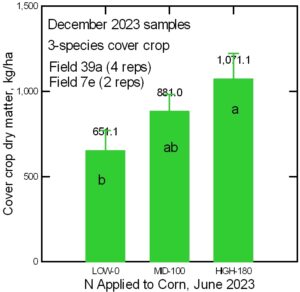
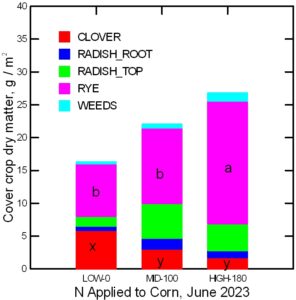
Cover Crop Root and Shoot Biomass Production 2024
Figure 3 illustrates observations on the root - shoot biomass. Shoot biomass changed very little with sampling dates that correspond to the early mid and late termination. However, the rye + clover vegetation (which is all that remained of the three-species cover crop) produced more shoot dry matter than the sole rye even though the latter had a more dense population. Root dry matter was affected by both the cover crop type and the sampling date. The greatest root dry matter from both the sole rye and the rye+clover occurred at the mid-termination time which was the end of April. The decline in root biomass between the mid and late kill dates does not necessarily represent less contribution of organic carbon to the soils. Rather the decrease in root DM may reflect carbon added to the soil during the the sloughing off of old roots and and regrowth of young ones. Shoot-to-root ratios varied with the type of cover crop and with the sampling date. The shoot-to-root ratios were lowest for the mid-sampling date and more than twice as high for the early and late sampling dates. For the late sampling date, the shoot-to-root ratio was almost twice as high for the rye +clover as for the sole rye. These data illustrate the inappropriateness of modeling cover crop below ground biomass by using a given shoot-root ratio for a given cover crop species.

Cover crop performance in 2024.
Cover crops produced moderate levels of biomass in the field experiments at the Central Maryland Research and Education Center (CMREC) Beltsville facility. This was partly due to less-than-ideal conditions for inter-seeding in the Fall of 2023 and also due to very cool and very dry conditions in April 2024. There was little difference in cover crop biomass between early mid and late termination dates, but the rye cover crop tended to increase biomass with time while the three-way cover crop dominated by crimson clover showed little change or even a slight decrease (figure, left). Nonetheless, cover crops and their residues did have an impact on soil moisture during the summer growing season which was extremely dry and hot. The cover crop effects began to show up in the soil moisture tension data in late June and by mid-July there was significantly more water available in the soil under the three-way cover crop than under the rye cover crop (figure below, right). The no-cover plots were intermediate in soil moisture. These data are based on averages for plots growing corn and soybeans, for the sandy soil and the silty clay soils, and measurements at 15 and 30 cm deep since none of these factors had a statistical effect on the soil moisture.
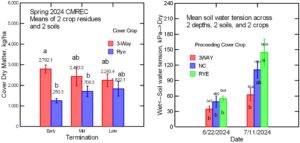
Slug Activity, Crop Damage, and Yields as Affected by Cover Crop Management
Study on Ridgely fields of James Lewis' Farm.
Monitoring of soil water, surface temperature, soil temperature, and slug numbers under shingle traps before the imposition of cover crop termination treatments and planting in the adjacent Ridgely fields revealed that the south field was significantly wetter than the north field. Slug numbers were weakly associated with soil moisture. Once the crops emerged, we monitored conditions and crop stand density on three dates for each field. The average data for the north field planted to corn are presented in Figure below. The late-killed (planted green) strips had slightly drier soil in the upper 5 cm, probably due to continued water transpiration by the cover crop during the very dry period in most of April. The corn stand establishment and stand density averaged over the three observation days were not affected by the cover crop termination treatments. Slug damage to crop seedlings was scored on three dates in each field. Seedling damage by slugs was scored from 0 (no damage visible) to 4 (damage so severe that the seedling died or will die, such as eating off the terminal growing point on soybean). The figure below shows the damage scores for corn on three dates. On all three observation days, there was significantly less slug damage in the late-killed (planted green) strips than in the conventional early-killed cover crop strips. However, the corn seedling dry weight per plant was significantly lower in the late termination strips.
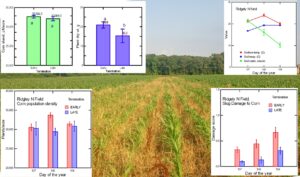
Unlike for corn in the adjacent field, later termination and planting green did not affect soybean stand population or slug damage at Lewis'' farm near Ridgley.
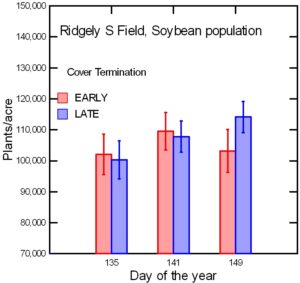
Effect of later termination and planting green on slug damage scores for soybean seedlings in Lewis farm field near Ridgely, MD on three dates.
The Figure below shows the number of slugs counted per shingle in the corn and soybean fields at Ridgely as averaged on five observation dates. The last two dates were after cash crop planting. These data are averaged across the termination timing strips. The slug infestation was only moderate and the cover crop termination treatment did not affect the number of slugs observed in either the corn or soybean fields. The Figure also shows the surface and soil (5 cm) temperature and volumetric moisture content on the same dates. slug damage score for corn and soybean seedlings averaged over three dates. In this trial, letting the cover crop grow until cash crop planting by planting green into the living cover crop did not affect slug numbers or crop stand density achieved, but did reduce slug damage to both corn and soybean seedlings. The much heavier cover crop biomass residue on the late-killed strips could enhance yields when the summer is dry and water conservation is a factor.
Slug study data for Lewis Farm fields at Ridgley, MD showing soil and surface temperature, soil moisture, and slug counts for the north field in soybean residue where corn was planted in 2024 and (right) south field in corn residue where soybean was planted in 2024.
Because the corn was clearly stunted, we sampled the V5-stage corn plants and determined their dry weight per plant and the nutrient content of the plant tissue. The tissue concentrations of most nutrients were not affected by the cover crop management, except higher levels of Zn, B, and N in the corn planted green into late terminated cover crop hairy vetch, most likely due to less dilution as in the bigger plants in the early terminated plots. The K levels are also shown because they were unusually high, probably because the field had been regularly fertilized with poultry manure, which is very high in available K.

In any case, the early season stunting carried through to the final yield. Corn yields were quite good in this irrigated field, but the late terminated strips yielded 71 bushels per acre lower (172 bu/acre) than the early termination strips (243 bu/acre, Figure below). Although 2024 was a very dry year during the growing season, these fields had the benefit of center pivot irrigation and water was not limiting. We propose that the stunting was not due to effects of nutrients, slugs, soil temperature, or water. We hypothesize that the timing of the hairy vetch termination with herbicides may have produced active allelopathic compounds just when the corn seeds were emerging. Soybeans in the adjacent field, in contrast to the corn, yielded well regardless of the timing of the winter wheat cover crop termination and planting green. Although he did not use row cleaners or residue rollers as suggested by Penn State University researchers (Reed, H. K., Karsten, H. D., Duiker, S., Tooker, J., and Curran, W. S. (2019). Planting green 101: Penn State research summary Penn State University. https://extension.psu.edu/planting-green-101-penn-state-research-summary ), Jim Lewis said that he has had poor results in the past with planting green for corn, but this 71-bushel loss was the last straw. He liked the results with the soybeans and plans to continue to experiment with planting green to improve his soil health when growing soybeans, but won't again try planting green for corn.
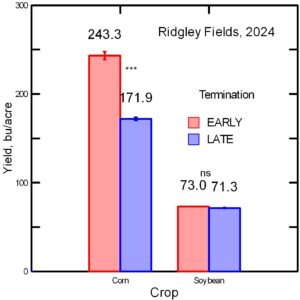
Study on the silty field (7E) at CMREC Beltsville Facility.
Of the two research fields at CMREC used in this project, Field 7E has fine-textured Christiana soil and a history of slug infestations. In the spring of 2024, we monitored the slugs and their impact on corn and soybean crops in this field in plots with rye, rye+clover, or winter weeds only. The average damage score increased over time during the first 10 days after emergence for both crops, but the damage from slugs was consistently worse on the soybeans than on the corn (Graph below).
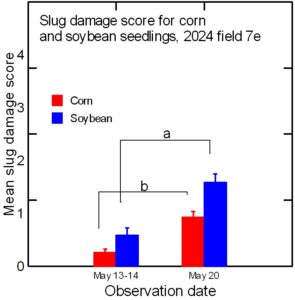
Slug damage to both corn and soybean seedlings was generally not made worse by allowing cover crops to grow longer. In fact, on some evaluation dates damage scores were lower for the late killed and planted green plots. These results are consistent with what we observed in the on-farm trials on the Eastern shore. In the graph below on May 20th 12 Days after planting corn and soybeans the slug damage to crop seedlings was significantly less severe in the late cover crop termination plots than in the nearly cover crop termination plots on average across all three cover crop treatments and both cash crops.
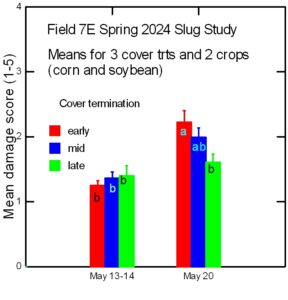
In addition to concerns about increasing slug damage, farmers are often concerned about longer-growing cover crops using up storage soil moisture. When making the slug counts and damage assessments we also measured soil moisture in the upper 5 cm of soil. Generally, the termination date did not affect this significantly and there was only a slight trend toward slightly drier soil in the plots with the longer-growing cover crop as shown in the graph below. Obviously, a much-needed rain was received between the May 13th observation and the May 20th observation date.
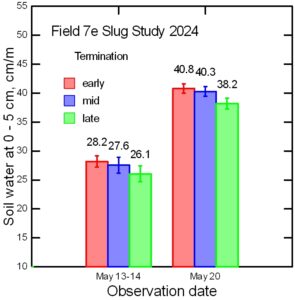
Cover crops did have a major effect on soil moisture conservation during the dry hot summer months. The spring and summer of 2024 were exceptionally dry on these non-irrigated plots. By June 22nd, a trend was beginning to emerge of greater moisture content (lower soil water tension) with the multi-species cover crop as compared to the rye, with the no-cover (winter weeds only) plots falling in between. With almost no rain received, by July 11 this trend was accentuated and was statistically significant. The graph below shows the soil water tension averaged across two soil depths (15 and 30 cm), two soils (a loamy sand field and a silty clay field ), and two crops (corn and soybeans). The reason why the rye cover crop resulted in dryer soil in the summer is uncertain but may have to do with the larger biomass and water uptake during its growing season, especially in April.
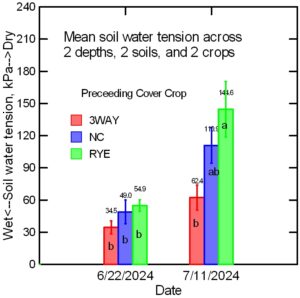
Cover crop effects carried through to final crop yields. As we have seen on other sites in dry growing seasons, corn yields with cover crops were significantly (p< 0.07) higher than in the no-cover control plots. Nonetheless, in this extremely dry year, non-irrigated corn yields were very low across the board, especially on the sandy soil.
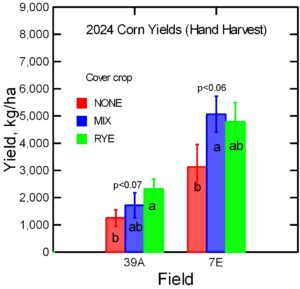
Averaged across the two contrasting soils at the Beltsville research farm, soybean yields were not significantly affected by cover crops and were not as extremely low as corn yields. However, there was an interaction between cover crop species and termination timing such that the early and late kill of the multi-species mix resulted in significantly lower soybean yields than the mid-kill which was planted green and terminated on the same day. This effect, we believe, was largely related to the weediness of the early and late terminated plots due to the dry weather at the time of herbicide spraying and the lack of moisture to ensure the herbicides were absorbed by the weeds. Therefore, summer weeds grew out of control and there was a significant negative relationship between weed biomass and soybean yield in these plots (data not shown).
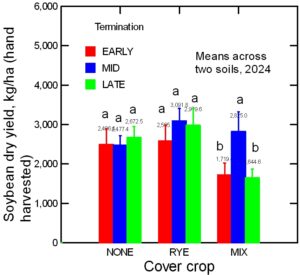
Education & Outreach Activities and Participation Summary
Educational activities:
Participation Summary:
During the first 6 months of this research project, the main outreach activities were a farmer extension newsletter story about the establishment of the new project and a workshop presentation that discussed spring cover crop management in organic systems for the Mid-Atlantic Crop School in Ocean City Maryland in November 2023.
In spring 2024 we planned and held a field day on May 9th, a few days after our research plot were planted green to corn and soybeans at the Central Maryland Research and Education Center Beltsville Farm. More than 50 people were in attendance for the field day which was held from 9:30 am to 2:30 pm. Farmers and ag service providers were invited to learn about our latest research on planting green techniques and slug control methods. Activities included a Planting green demonstration, Biomass and root sampling activities, a Soil pit investigation, Slug scouting and control methods. Single species and cover crop mixes were demonstrated on widely contrasting soil condition (very sandy v. silty clay).
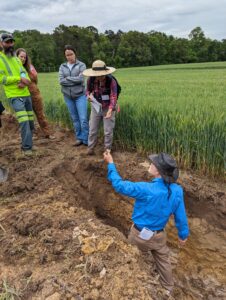
Learning Outcomes
Survey of participants for May 9, 2024 Cover Crop Spring Management Field Day at Beltsville, Facility University of Maryland. NE SARE Spring Mgt of Cover Crops Research Project.
|
Level of knowledge about cover crops before and after the field day activities. (Total of 21 respondents, 40% farmers) |
||||||||||
|
# |
Question |
None |
Very Little |
Average |
A Lot |
None |
Very Little |
Average |
A Lot |
|
|
BEFORE FIELD DAY ACTIVITIES |
AFTER FIELD DAY ACTIVITIES |
|||||||||
|
1 |
Various cover crop purposes |
0.00% |
28.57% |
47.62% |
23.81% |
0.00% |
0.00% |
42.86% |
57.14% |
|
|
2 |
Tailoring cover cropping to cash crop rotations and planting windows |
5.00% |
40.00% |
45.00% |
10.00% |
0.00% |
5.26% |
47.37% |
47.37% |
|
|
3 |
Planning and designing cover crop mixes |
19.05% |
28.57% |
33.33% |
19.05% |
0.00% |
9.52% |
38.10% |
52.38% |
|
|
4 |
Cover crop planting and termination options |
14.29% |
19.05% |
52.38% |
14.29% |
0.00% |
0.00% |
26.32% |
73.68% |
|
|
5 |
The importance of cover crop residue and carbon to nitrogen ratios |
4.76% |
28.57% |
33.33% |
33.33% |
0.00% |
4.76% |
42.86% |
52.38% |
|
|
As a result of the field day, how likely you are to take these actions (farmers) OR advise others to take these actions (ag service providers)? |
|
|||||
|
# |
Question |
Not at all likely |
A little likely |
Somewhat likely |
Very likely |
|
|
1 |
Evaluate various cover cropping options, rather than just blanket applying 'a cover crop' on the farm |
0.00% |
0.00% |
23.81% |
76.19% |
|
|
2 |
Plant cover crop mixes |
4.76% |
4.76% |
19.05% |
71.43% |
|
|
3 |
Plant cover crops earlier in the fall than I typically do |
5.26% |
0.00% |
47.37% |
47.37% |
|
|
4 |
Allow cover crops to grow later in the spring than I typically do |
5.00% |
0.00% |
55.00% |
40.00% |
|
|
5 |
Plant a cover crop more likely to benefit my following cash crop (e.g., include a N-fixing legume in a mix ahead of corn) |
5.26% |
0.00% |
26.32% |
68.42% |
|
|
6 |
Modify cash crop rotations in order to open windows for cover crops that will serve more purposes |
10.53% |
5.26% |
36.84% |
47.37% |
|
